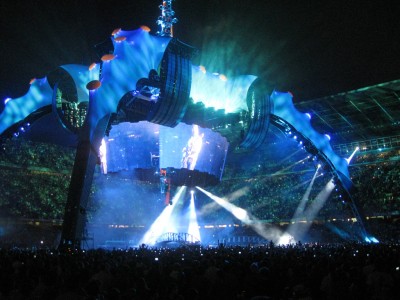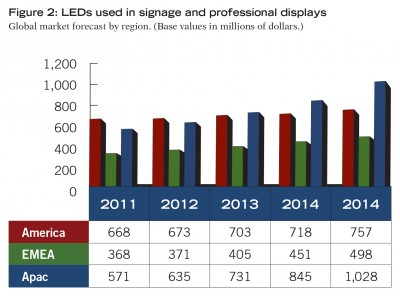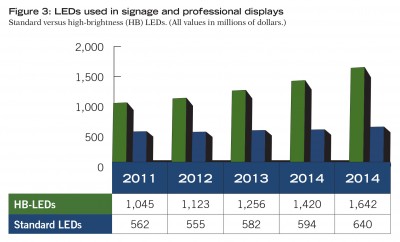
In 2009, a ‘transformable’ screen for U2’s 360° world concert tour used more than 500,000 LEDs as pixels. Photos courtesy Barco
They are also more compact, enabling the design of narrower-profile LCDs.
Retail displays
Rensselaer Polytechnic Institute’s (RPI’s) Lighting Research Center (LRC) in Troy, N.Y., established the Alliance for Solid-State Illumination Systems and Technologies (ASSIST) in 2002 as an industry partnership to foster collaboration between researchers, manufacturers and government organizations, with the purpose of facilitating the broad adoption of SSL by helping to reduce major technical and market barriers.
Together, LRC and ASSIST have developed new ‘metrics’ to aid in specifying optimal light sources to illuminate retail displays. They recommend using the Color Rendering Index (CRI), which measures the ‘natural’ quality of colours, with the Gamut Area Index (GAI), which targets the relative separation of colours in an illuminated object. A higher GAI means greater saturation or vividness. LRC experiments show light sources that balance CRI and GAI are generally preferred over those that emphasize only one or the other.
Similarly, the National Institute of Standards and Technology (NIST) recently developed the Color Quality Scale (CQS) and proposed it as a standard to the International Commission on Illumination/Commission Internationale de l’Éclairage (CIE).

 Retail accent lighting is a growing market for LEDs because they can vary in colour and aim light precisely onto display areas or specific products. Their small form factor allows them to be used unobtrusively in applications like jewellery display cases, where a ‘point source’ of light can add more sparkle.
Retail accent lighting is a growing market for LEDs because they can vary in colour and aim light precisely onto display areas or specific products. Their small form factor allows them to be used unobtrusively in applications like jewellery display cases, where a ‘point source’ of light can add more sparkle.
Also, as LEDs do not radiate heat, they allow greater design flexibility when lighting temperature-sensitive goods, such as cosmetics and food. In 2010, Nualight introduced the Porto 600 line of glass door lighting for food retailers. These 8.5- to 16-W lamps are among the lowest-energy-consuming LEDs in the market, yielding 60 to 70 per cent savings compared to similar products. A single 100-W driver can easily support a five-door case.





